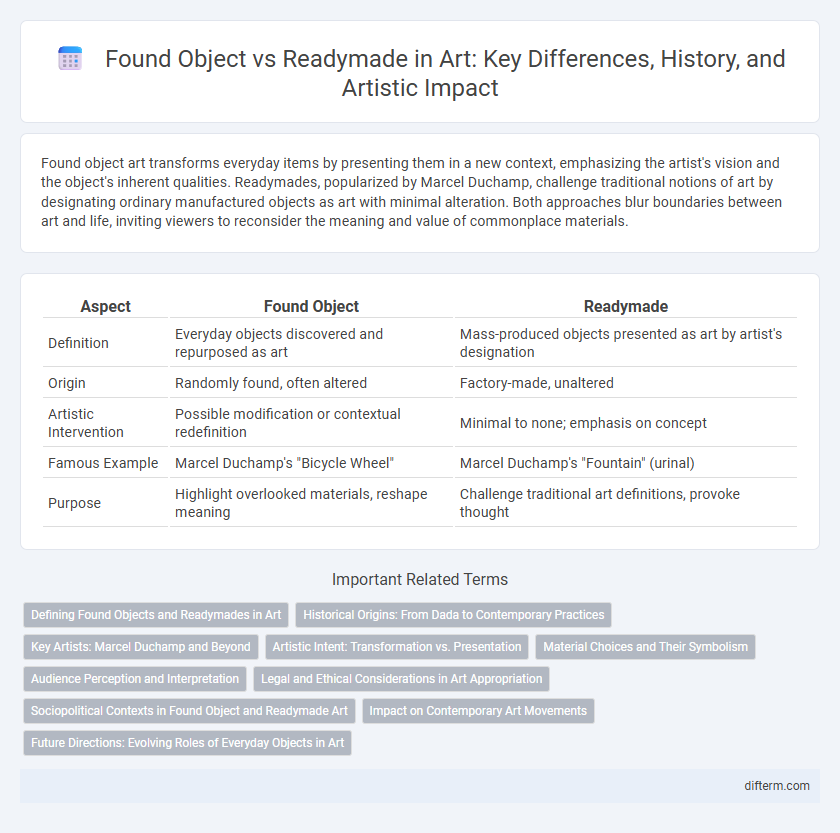Found object art transforms everyday items by presenting them in a new context, emphasizing the artist's vision and the object's inherent qualities. Readymades, popularized by Marcel Duchamp, challenge traditional notions of art by designating ordinary manufactured objects as art with minimal alteration. Both approaches blur boundaries between art and life, inviting viewers to reconsider the meaning and value of commonplace materials.
Table of Comparison
| Aspect | Found Object | Readymade |
|---|---|---|
| Definition | Everyday objects discovered and repurposed as art | Mass-produced objects presented as art by artist's designation |
| Origin | Randomly found, often altered | Factory-made, unaltered |
| Artistic Intervention | Possible modification or contextual redefinition | Minimal to none; emphasis on concept |
| Famous Example | Marcel Duchamp's "Bicycle Wheel" | Marcel Duchamp's "Fountain" (urinal) |
| Purpose | Highlight overlooked materials, reshape meaning | Challenge traditional art definitions, provoke thought |
Defining Found Objects and Readymades in Art
Found objects in art refer to natural or man-made items discovered and repurposed without alteration, emphasizing the inherent aesthetic or conceptual value. Readymades, pioneered by Marcel Duchamp, involve selecting manufactured objects and presenting them as art with minimal or no modification, challenging traditional notions of creativity and artistic authorship. Both concepts revolutionized contemporary art by shifting focus from craftsmanship to context and meaning.
Historical Origins: From Dada to Contemporary Practices
Found objects emerged as everyday materials repurposed in art, tracing their roots to early 20th-century Dadaism, which challenged traditional aesthetics and artistic conventions. Readymades, popularized by Marcel Duchamp, transformed ordinary manufactured objects into art by selection and designation, fundamentally altering art's definition and role. This shift influenced contemporary practices by encouraging artists to explore context, meaning, and the boundaries between art and life through object appropriation.
Key Artists: Marcel Duchamp and Beyond
Marcel Duchamp revolutionized modern art with his concept of the readymade, transforming everyday objects like a bicycle wheel or a urinal into provocative artworks by selecting and presenting them as art. The found object, while similar, emphasizes the discovery and recontextualization of items in natural or accidental states rather than deliberate artistic selection. Beyond Duchamp, artists such as Robert Rauschenberg and Joseph Cornell expanded on these ideas, integrating found objects into assemblages that challenge traditional boundaries between art and life.
Artistic Intent: Transformation vs. Presentation
Found object art emphasizes transformation, where artists alter everyday items to create new meanings and challenge traditional aesthetics. Readymade art centers on the presentation of unaltered objects, highlighting conceptual intent by recontextualizing them within an artistic framework. The key distinction lies in the degree of physical modification: found objects undergo visible change, whereas readymades rely solely on the artist's designation to confer artistic value.
Material Choices and Their Symbolism
Found objects in art involve selecting everyday materials that carry inherent meanings from their original context, emphasizing narrative depth and cultural associations. Readymade art repurposes manufactured items, stripping them from their functional roles to challenge traditional artistic values and provoke discussions on authorship and originality. Material choices in both forms symbolize a dialogue between art and society, reflecting shifts in perception about value, utility, and artistic intention.
Audience Perception and Interpretation
Found objects in art often invite audiences to explore everyday items transformed through context, prompting personal connections and diverse interpretations based on familiarity and cultural background. Readymades challenge viewers by presenting mass-produced objects as art with minimal alteration, provoking questions about authorship, originality, and artistic intent. Audience perception shifts as the boundary between ordinary object and artistic creation blurs, encouraging critical reflection on value and meaning within contemporary art practices.
Legal and Ethical Considerations in Art Appropriation
Found objects in art involve incorporating everyday materials without significant alteration, raising complex legal issues regarding ownership and copyright infringement. Readymades, popularized by Marcel Duchamp, challenge traditional notions of originality but often spark ethical debates about artistic authorship and cultural appropriation. Navigating these concerns requires careful consideration of intellectual property laws and respecting the provenance of appropriated materials.
Sociopolitical Contexts in Found Object and Readymade Art
Found object and readymade art challenge traditional art boundaries by transforming everyday items into artistic statements, reflecting sociopolitical critiques of consumerism, class, and industrialization. Found objects often carry historical or cultural narratives that comment on social identity and marginalization, while readymades, pioneered by Marcel Duchamp, emphasize the artist's intent to question artistic authorship and the elitism of art institutions. Both forms serve as vehicles for subversion and discourse, highlighting power dynamics and societal structures through repurposed materials.
Impact on Contemporary Art Movements
Found objects transformed contemporary art by introducing everyday materials into the creative process, challenging traditional notions of craftsmanship and originality. Readymades, popularized by Marcel Duchamp, redefined artistic authorship and emphasized concept over technique, catalyzing movements like Dada and Conceptual Art. Both approaches expanded the boundaries of art, influencing Pop Art, Assemblage, and Postmodernism by encouraging the recontextualization of ordinary objects within new aesthetic frameworks.
Future Directions: Evolving Roles of Everyday Objects in Art
Found objects and readymades continue to reshape contemporary art by challenging traditional notions of creation and authorship. Artists increasingly integrate technology and sustainability, transforming everyday items into interactive, eco-conscious installations. This evolution highlights the fluidity of artistic mediums, fostering new dialogues around material value and cultural significance.
Found object vs Readymade Infographic

 difterm.com
difterm.com